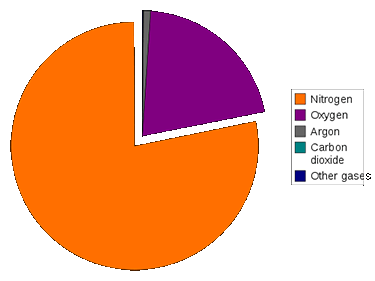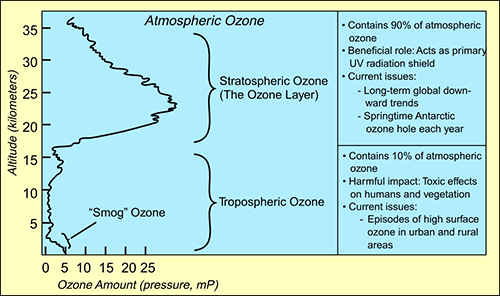Learn

The Basics
The earth's atmosphere is vital to the existence of life on earth.
It provides the air that we breathe.
The atmosphere is also responsible for creating a planet that has temperatures that can support life.
The earth's atmosphere plays a major role in creating the earth's weather. The atmosphere is where most weather events are generated and occur. Think back to Unit 3 and the water cycle. The atmosphere is an integral part of that cycle. This is important to earth for supplying water to earth's surface in the form of precipitation.

Composition
The earth's atmosphere is a layer of gases that extend from earth's surface to space. The atmosphere envelops completely surrounds the earth like a blanket. The earth's atmosphere is composed of
- 78% nitrogen (N2),
- 21% oxygen (O2), and
- 1% water vapor and other trace gases, such as carbon dioxide, carbon monoxide, methane, and argon.
All of these gases combine to absorb ultraviolet radiation from the sun. This warms earth's surface through heat retention.

This pie chart illustrates the breakdown by percentage of gases in the Earth's atmosphere. Note that more than 3/4 of the earth's atmosphere is nitrogen and most of the rest is oxygen. Only a very small sliver - around 1% - is carbon dioxide, argon, and other trace gases.
The earth's atmosphere is divided into 4 different layers — troposphere, stratosphere, mesosphere, and thermosphere — based on physical and chemical characteristics of the atmosphere.

Troposphere

Stratosphere

Mesosphere

Thermosphere

Summary
Visit Layers of Earth's Atmosphere to learn more about the layers of the earth's atmosphere.

This graph illustrates the change in temperature based on altitude for the layers of the atmosphere. Height is measured along the vertical axis in km on the left and in miles on the right. Temperature is along the horizontal axis. Please note that temperature decreases as you move further up in the troposphere, stabilizing at -40°C, then increases back up to 0°C throughout the stratosphere. Temperature decreases again in the mesosphere down to almost -100°C before rising and exceeding 60°C through the thermosphere.
Click for a larger version.
Notice that temperature is both directly proportional and inversely proportional to change in altitude depending on the layer.
Also take note that atmosphere pressure is inversely proportional to the increase in altitude — as the altitude increases, atmospheric pressure decreases.
 |
 |




